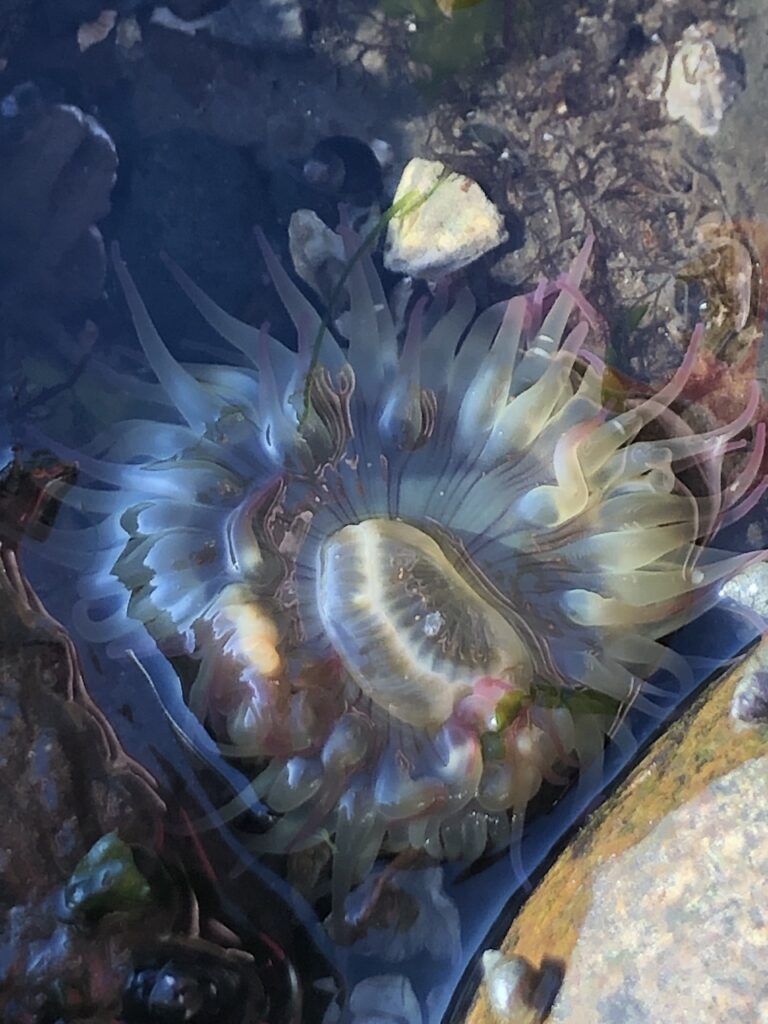As somebody who often needs to sit and rest during their outdoor adventures, tide pools have served as endless sources of fascination for me as I sit by the ocean. Last year, I began taking time-lapse videos of tide pools to observe how the creatures that live within them react and change as the water moves in and out.
One of the most interesting changes I observed were with aggregating anemones. When the water goes completely out, it can be incredibly difficult to notice them unless you’ve trained your eyes to spot them. Rather than looking like multi-colored underwater flowers, these anemones resemble something more like a grape or olive when the water recedes. They are often tucked away in the nooks between and beneath large rocks on the shore, or in cracks in the rock that cover the shore.



I became very interested in how these anemones transition from an underwater flower to what is essentially a shore-grape as the tide goes out. I wanted to understand how this happens in real time, but let’s be honest – it can be quite the task sitting there and waiting for the tide to go out. And even if you can wait, sometimes they change so quickly that if you look away for just a moment, you might miss something very interesting.
So I decided to set up a time-lapse video to record the process. To do so, I went to a less-busy beach in a not-so-popular time of year (November, brrr) to ensure that my setup would be out of the way and would, in turn, not be disturbed. I used a flexible tripod that I borrowed from a friend and attached my phone to it, which has a time-lapse recording function.
I made sure to set up the tripod in a place that was secure enough to withstand any wave action as the tide went in or out, usually by carefully placing it between rocks. The water, of course, couldn’t be too deep or the tripod and my phone would be whisked away, so I also had to identify an anemone large enough to be seen by my camera but in shallow enough water that the tripod would be secure.
Retracting Tentacles and Crab Battles
I had so much fun spending an afternoon recording anemones slowly change from their sea-forms to their land-forms. I learned that the outer “column” wall of the anemone starts to rise as the water goes out, making it seems like its tentacles are being retracted into their body. Once this outer protective wall covers its entire body and all of its tentacles are secured inside, it looks neatly bound up in a small, sphere-like package.
Even more interesting than just the anemones were the interactions they had with other creatures! In this video, you can see not only small sea snails waddling along at an accelerated pace thanks to the stop motion (which makes it look adorable), but you can also see the anemone combat a small crab!
At approximately the 00:27 mark in the video, there starts to be an awful lot of movement on the left side of the anemone. It is rather poor timing for the anemone, as it seems about halfway through the process of covering itself up (or grape-ifying, as I like to call it). Nevertheless, you can see the anemone lash out using its tentacles to fend off the crab before it resumes (and finishes) preparing itself for the tide going out.
While it was still pretty time-consuming to wait out the whole process and to find anemones in the right physical locations to film, it was an incredibly interesting and accessible activity that I plan on repeating. It really opened the door to observing creatures that may look static at first glance, but are showing really intriguing behaviors across larger time spans.



